
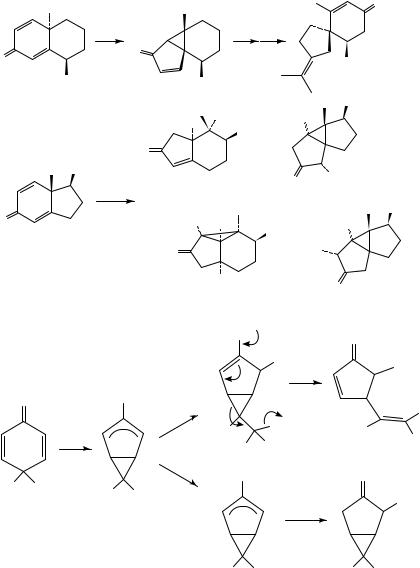
|
7. Application to the synthesis of complex molecules |
283 |
|||||
|
|
|
|
|
|
|
O |
|
hν |
|
|
|
|
|
|
O |
|
|
O |
|
|
|
|
|
|
|
|
|
|
|
|
(91) |
|
|
|
|
|
|
|
|
|
|
|
|
|
OTBDPS |
|
|
|
|
OAc |
|
|
H |
|
|
|
|
H |
|
|
|
|
|
|
|
OTBDPS |
|
|
||
|
|
|
|
|
|
||
|
|
|
O |
|
+ |
|
|
|
OTBDPS |
|
|
|
|
OAc |
|
|
|
|
|
|
O |
|
|
|
|
|
(93) |
34% |
16% |
|
|
|
hν |
|
|
||||
|
|
|
|
|
|
||
|
A cOH |
H H |
|
|
|
OTBDPS |
|
O |
|
|
|
|
H |
|
|
(92) |
|
|
|
|
OTBDPS |
|
|
|
|
+ O |
|
+ |
AcO |
|
|
(TBDPS = SiPh2 Bu-t) |
|
|
|
||||
|
|
|
|
|
|
||
|
|
|
OAc |
|
|
|
|
|
|
|
19% |
|
O |
4% |
|
|
|
|
SCHEME 23 |
|
|
|
|
|
|
|
|
O− |
|
O |
|
|
|
|
|
|
|
|
|
|
|
|
|
|
OMe |
|
OMe |
|
|
|
|
|
|
|
|
O |
|
O− |
|
|
|
|
Cl |
|
|
|
MeOH |
|
|
|
|
|
|
|
|
Cl |
H3 C |
|
|
|
|
|
H3 C |
|
|
||
|
hν |
+ |
|
|
Cl |
||
|
|
Cl |
Cl |
|
|||
|
|
|
(97) |
||||
|
|
|
|
|
|
||
H3 C CCl3 |
|
|
H+ |
OH |
|
O |
|
H3 C |
|
|
|
|
|
||
|
|
CCl3 |
|
|
|
OMe |
|
(94) |
|
(95) |
|
|
|
|
|
|
|
+ |
MeOH |
|
|||
|
|
|
|
|
|||
|
|
|
|
|
|
|
|
|
|
|
H3 C |
CCl3 |
H3 C |
CCl3 |
|
|
|
|
|
(96) |
|
(98) |
|
SCHEME 24
Direct interception of the initially formed bicyclic oxyallyl zwitterion derived from cyclohexadienones is difficult, due to its facile rearrangement to cyclopropyl ketone. One notable exception is the observation that 4-trichloromethyl-substituted dienone 94 gave solvent adduct 97 when irradiated in methanol, and both 97 and 98 upon irradiation in acidic methanol (Scheme 24)48. It was proposed that 97 arises either from a facile
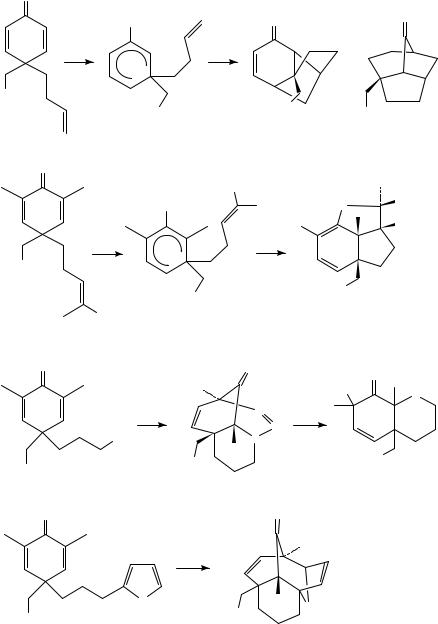
284 |
John M. Nuss and Frederick G. West |
|
||
O |
|
|
|
|
|
O− |
|
O |
O |
hν |
+ |
|
+ |
|
|
|
|||
OAc |
|
|
|
|
|
AcO |
|
AcO |
OAc |
|
|
|
||
(99a) |
|
|
(100) |
(101) |
O |
|
|
|
|
|
|
HOH2 C |
|
|
|
−O |
|
O |
CH2 OH |
|
|
|
|
H |
hν |
+ |
|
|
|
OAc |
|
|
|
|
|
|
AcO |
AcO |
|
|
|
|
|
|
CH2 OH |
|
|
(102) |
|
(99b) |
|
|
|
|
O |
|
|
O |
O |
|
|
|
|
|
|
|
|
HO |
H |
|
|
|
N |
|
|
|
|
|
|
|
hν |
|
N |
|
|
|
H2 O |
|
|
|
PhH |
|
N |
|
|
|
N |
|
|
|
N3 |
|
|
|
OAc |
|
AcO |
|
AcO |
|
|
13% overall |
||
|
|
|
||
(103) |
|
(104) |
|
(105) |
O |
|
|
O |
|
|
|
hν |
|
|
|
O |
|
O |
|
OAc |
|
AcO |
|
|
|
|
|
||
|
|
|
|
|
(106) |
|
|
(107) 100% |
|
SCHEME 25
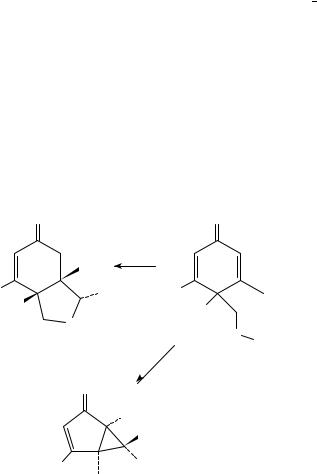
7. Application to the synthesis of complex molecules |
285 |
fragmentation pathway available to the zwitterion 95, or by solvent capture of 95 followed by fragmentation. Irradiation in an acidic medium would likely involve hydroxyallyl cation 96, which would undergo solvent capture without fragmentation to give 98.
Given the typically rapid rearrangement of the first zwitterion, Schultz and coworkers have focused on trapping processes involving the 1,5-zwitterion arising from secondary photochemistry of the initially formed cyclopropyl ketone (Scheme 25)49. Pendant alkenes, as exemplified by substrates 99a and 99b, can intercept the zwitterion in a variety of modes, leading to both bridged and fused polycyclic products 100 10249c. Formal 3 C 2 cycloadducts 101 and 102 almost certainly arise from a stepwise pathway with initial cationic cyclization, followed by ring closure with either C O or C C bond formation. Pendant 4 traps can also be used to capture the zwitterion in a concerted cycloaddition process. For example, azide 103 could be converted to the highly functionalized triazine 104, which underwent an unusual, water-mediated loss of dinitrogen to furnish hexahydroquinolone 10549a. Likewise, furan-containing substrate 106 gave [4 C 3]-adduct 107 in excellent yield.
More recently, Schultz and coworkers have reported competing hydrogen abstraction chemistry for dienone substrates containing a 4-alkoxymethylene substituent50. For example, benzyl ether 108a was efficiently converted into bicyclic ether 109 as a single diastereomer (Scheme 26). This presumably proceeds through transfer of a benzylic hydrogen to the ˛-position of the excited dienone, followed by collapse of the resulting biradical. In contrast, dienone 108b, containing an all-carbon side-chain, underwent typical dienone photochemistry to produce 110.
O |
|
O |
|
|
hν |
|
|
(X = O) |
MeO |
Ph |
MeO |
MeO2 C |
|
MeO2 C |
|
O |
|
X
CH2 Ph
(109) |
hν |
(108a) |
X =O |
|
(X = CH2 ) |
(108b) |
X =CH2 |
|
O |
|
|
|
H |
|
|
|
CO2 Me |
|
|
MeO |
(CH2 )3 Ph |
|
|
(110)
SCHEME 26
Analogous olefin trapping chemistry employing 2,7-cyclooctadienone has been investigated51. With this substrate, the oxyallyl zwitterion 112 could be intercepted intermolecularly with simple alkenes in a (presumably stepwise) 3 C 2 manner (Scheme 27). Importantly, intermediate 112 differs from 2,5-cyclohexadienone-derived zwitterions in terms of its lack of a facile rearrangement pathway. An interesting side-issue
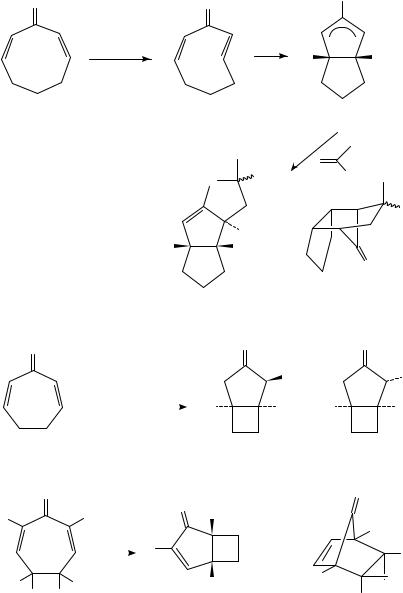
286 |
John M. Nuss and Frederick G. West |
|
|
O |
O |
|
O− |
|
|
||
|
hν, hexanes |
|
+ |
|
H |
H |
|
|
0 °C |
||
|
|
|
|
|
(111) |
|
(112) |
|
|
|
|
|
|
|
O |
|
OMe |
|
OMe |
|
|
|
|
|
|
|
|
|
|
|
|
|
|
|
|
|
|
|
|
|
|
|
|
|
|
OMe |
|
|
|
|
|
|
|
|
+ |
|
|
||
|
|
|
|
|
|
|
|
|
H |
|
|
|
|
|
|
|
|
H |
|
|
H |
|
|
||
|
|
|
|
|
|
|
|
|
|
|
|
O |
|
|
|
|
|
|
33% |
|
|
|
|
29% |
|
|
|
|
|
|
|
SCHEME 27 |
|
|
||||
O |
|
|
|
|
|
|
|
|
O |
|
O |
|
|
|
|
|
|
|
|
|
|
|
|
|
|
|
|
|
|
|
|
|
|
|
|
OR |
|
OR |
|
|
|
hν |
|
|
H |
|
|
H |
+ H |
H |
|
|
|
|
|
|
|
|
|
|
||||
|
|
|
A cOH or |
|
||||||||
|
|
|
|
|
|
|
|
|
|
|||
|
|
t-BuOH/cat. H2 SO4 |
|
|
|
|
|
1 : 1 |
|
|||
(113) |
60 % |
|
|
(114a) R = Ac |
|
(115a) R= Ac |
||||||
|
|
|
|
|
|
|
||||||
|
|
|
|
|
|
|
(114b) R= t-Bu |
|
(115b) R= t-Bu |
|||
O |
|
|
|
|
|
|
|
|
|
|
|
O |
|
|
|
|
|
|
O |
|
|
|
|
|
|
R |
|
R |
|
|
R |
|
OMe |
|
R |
|||
|
|
|
|
|
|
|
|
|
|
OMe |
|
|
|
|
|
hν |
R |
|
|
|
|
|
|
||
|
|
|
|
|
+ |
|
OMe |
|||||
|
|
|
|
|
|
|
|
|||||
|
|
|
|
|
|
|
|
|
|
OMe |
R |
OMe |
|
|
|
|
|
|
|
|
|
|
|||
|
|
|
|
|
|
|
|
|
|
|
||
MeO |
OMe |
|
|
H |
OMe |
|||||||
|
|
|
OMe |
|||||||||
MeO |
OMe |
|
|
|
|
|
|
|
OMe |
|||
|
|
|
|
|
|
|
|
|
|
|
|
|
|
|
|
|
|
|
|
47 − 50% |
|
4 − 10% |
|||
(116a) R= H |
|
|
(117a) R= H |
|
(118a) R= H |
|||||||
(116b) R= Me |
|
|
(117b) R= Me |
|
(118b) R= Me |
|||||||
(116c) R= Pr |
|
|
(117c) R= Pr |
|
(118c) R= Pr |
|||||||
SCHEME 28

7. Application to the synthesis of complex molecules |
287 |
concerns the mechanism by which 112 is generated, which may differ from the pathway described above (Scheme 21). The authors report evidence for the prior formation of a short-lived, ground-state intermediate at low temperature, which then rearranges to 112 upon warming, and propose highly strained E,Z-dienone 111 as a candidate for this intermediate.
The analogous 2,6-cycloheptadien-1-ones display zwitterion-derived reactivity as well52,53. For example, the parent compound 113, upon irradiation in either acetic acid or t-butanol, gave diastereomeric solvent adducts 114 and 115 (Scheme 28)52a. On the other hand, tetramethoxy derivatives 116 furnished rearranged products 117, which are equivalent to the cyclopropyl ketone 1,4-shift products seen with cyclohexadienones52b.
|
O |
O |
|
R |
|
|
|
|
|
|
R |
||
|
|
|
|
|
O |
|
|
|
|
|
|
|
|
|
|
hν |
R |
R |
+ |
|
|
|
|
|
|
R |
CHO |
R |
O |
R |
O |
|
O |
O |
|
|
|||||
|
|
|
R |
major |
(121) ca 1% |
|
|
(119) |
|
|
|
||
|
|
|
product |
|
||
|
R= Me, Ph |
|
|
|
H + |
O |
|
|
|
O |
|
|
|
|
|
|
|
|
|
|
|
|
|
|
|
MeOH |
O |
|
|
|
|
|
|
|
|
|
|
|
|
hν |
|
 O
O
R R
(120)
O−
O
hν |
+ |
MeOH |
O
O
(123)
O  O
O
CF3 CH2 OH
O
O
O
H 
HO
(125)26 − 37%
SCHEME 29
R
R
(122)
OH
OMe
O
O
OMe
OH
(124) 80%
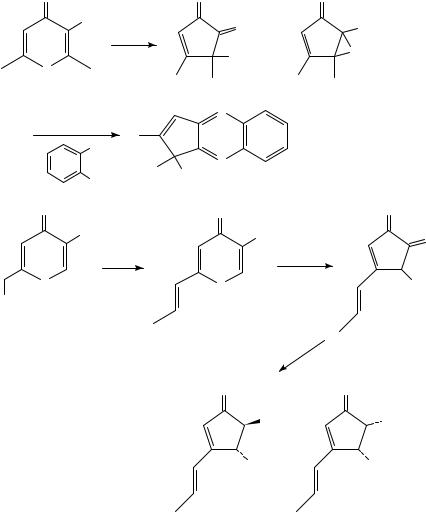
288 |
John M. Nuss and Frederick G. West |
In addition to 117, varying amounts of 7-norbornenones 118 were also isolated, apparently resulting from the 1,3-shift of 117.
Pyran-4-ones bear an obvious structural similarity to the all-carbon cyclohexadienones discussed above. However, the original studies of their photochemical behavior revealed only dimerization processes to produce a cage product resulting from two successive head-to-tail [2 C 2]-photocycloadditions (Scheme 29)54. Much later, small amounts of substituted furfural 121 were observed during the irradiation of 11955a. It was speculated that 121 could arise from bicyclic epoxide 120, an intermediate analogous to those formed in cyclohexadienone photochemistry. Subsequent reports noted that further irradiation of
O
OH
hν
MeOH
26%
O
(126)
1. hν, MeOH
126
NH2
2.
NH2
49%
O
OH
3 steps
|
O |
OH |
kojic acid |
|
O |
O |
O |
OH |
+ |
O |
OH |
|
(127a) |
(127b) |
N |
|
N |
|
OH |
|
(128) |
|
O |
O |
|
|
OH |
O |
|
|
|
hν |
|
H2 O, 0 °C |
O |
OH |
(129) |
|
|
NaBH3 CN |
O |
O |
OH |
OH |
OH |
OH |
(130a) 8% |
(130b) 25% |
SCHEME 30
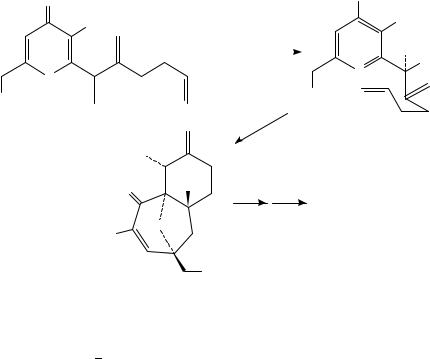
|
7. Application to the synthesis of complex molecules |
|
289 |
||
|
O |
OTBS |
|
||
|
|
|
|||
|
OTBS |
|
O− |
||
|
|
|
|||
|
|
PhCH3 , 200 °C (77%) |
|
Me |
|
|
|
|
|
|
|
|
|
or C6 H12 , hν, rt (15 %) |
+ |
H |
|
|
O |
O |
|
||
|
|
|
|||
OTBS |
|
|
OTBS |
|
|
|
|
|
|
|
|
|
(131) |
|
|
|
|
|
[3+2] |
|
|
|
|
O H
Phorbol
O
TBSO
OTBS
(132)
SCHEME 30. (continued)
120 led to 2-pyrone 122, while exposure of 120 to acidic methanol furnished 12155b,c. The photochemical behavior of 4-pyrones in dilute solutions of polar solvents has been examined in detail56 58. Rearrangement from 4- to 2-pyrones was found to be a major pathway, and the disposition of the ring substituents suggested the intermediacy of bicyclic zwitterion 123. The isolation of solvent adducts 124 provided strong evidence for this intermediate. In addition, irradiation in the presence of excess furan led to photoadduct 125, via a thermally allowed [4 C 3]-cycloaddition of the oxyallyl zwitterion and the diene58. Analogous rearrangement of 4-hydroxypyrylium ions to 2-hydroxypyrylium salts was also reported59.
Substitution with a 3-hydroxy group permits an alternative rearrangement pathway for the zwitterion via deprotonation (Scheme 30). For example, 2,6-dimethyl-3-hydroxy-4- pyrone 126 was converted photochemically to a mixture of hydroxy dione 127a and epoxy hemiketal 127b60a. Irradiation in the presence of phenylenediamine allowed for an improved yield via in situ trapping of the dione to give 128. A similar transformation was reported involving 3-hydroxy-6-propenyl-4-pyrone 129, prepared in three steps from readily available kojic acid60b. In situ reduction gave both the natural product terrein 130a and its diastereomer 130b. Use of a 3-silyloxy substituent led to the intervention of an entirely different mechanism. Kojic acid derivative 131, with a pendant olefin trap, underwent either photochemical or thermal silatropic shift to give a 4-silyloxy-3- oxidopyrylium salt. This intermediate underwent an intramolecular [3 C 2]-cycloaddition to give 132, which was used in the total synthesis of phorbol61.
A 2-step route to oxygenated bicyclo[n.3.0]alkanes via bicyclic 4-pyrones such as 133 has been reported (equation 2)62. Irradiation in hydroxylic solvents caused ring contraction to the zwitterion, followed by solvent incorporation to give fused bicyclic cyclopentenone 134. Good regioselectivity in favor of solvent capture at the more substituted oxyallyl terminus was seen in differentially substituted examples, presumably due to increased
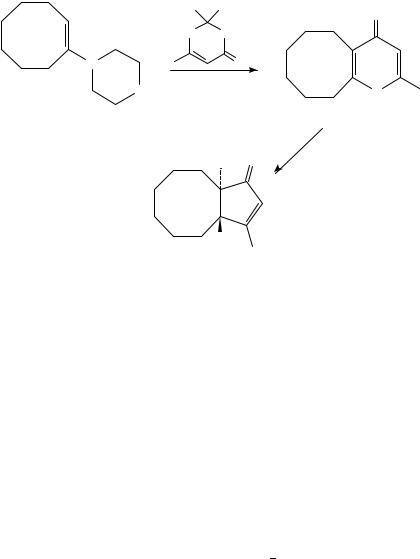
290 |
John M. Nuss and Frederick G. West |
charge density at that carbon. Attack by solvent was typically anti to the zwitterion epoxide, resulting in a trans ring-fusion.
|
|
|
O |
O |
O |
|
|
N |
|
O |
|
O |
160 °C |
|
O |
88% |
|
||
|
|
|
(133) |
|
|
MeOH |
(2) |
|
|
59% |
hν |
|
MeO |
O |
OH
(134)
The efficiency of the nucleophilic trapping process could be improved by rendering it unimolecular, permitting a wider range of traps. A polar, protic solvent was necessary for efficient photochemical conversion, consistent with the intervention of a , Ł excited state. This requirement permits a possible competition between the desired intramolecular reaction and intermolecular trapping. 2-Hydroxyalkyl-4-pyrones 135 furnished good yields of intramolecular trapping products 136 in methanol, and only minor amounts of the corresponding solvent adducts (Scheme 31)63. Solvent capture could be suppressed completely by use of the less nucleophilic trifluoroethanol. Pendant carboxylic acids were also used as internal traps, giving lactone-fused cyclopentenones 13764. Prior proton transfer to generate a more reactive electrophile/nucleophile pair was deemed a likely possibility in this process. Preliminary studies indicate that a benzyl ether can intercept the zwitterion, with subsequent debenzylation, to give a bicyclic ether identical to that obtained from irradiation of the corresponding free alcohol65. Aldehydes were also found to trap through oxygen, giving epimeric bicyclic mixed acetals 138 after solvent addition to the resulting oxocarbenium ion65.
Neutral, -rich carbon nucleophiles also served as effective internal traps66. Irradiation of 139a in trifluoroethanol at room temperature led to rapid consumption of the starting 4-pyrone and formation of one principal new product, tricyclic mixed ketal 140 (Scheme 32). A second compound, determined to be hydrolysis product 141a, was formed in trace quantities during chromatography, and could be obtained quantitatively from 140 by treatment with dilute acid. Notably, two new carbon carbon bonds were formed and three new stereocenters were set with complete control in this process. By varying the olefin substitution pattern (e.g. 139b), the cationic cyclization step could be switched from a 5-exo to a 6-endo mode. Substitution at C-3 had a pronounced effect on the stereoselectivity of the cyclization. In those cases bearing only hydrogen at C-3, a mixture of products was obtained, arising from unselective closure to a mixture of epimeric tertiary carbocations. On the other hand, complete diastereoselectivity in favor of an endo-oriented carbocation (the product of a compact transition state) was observed in
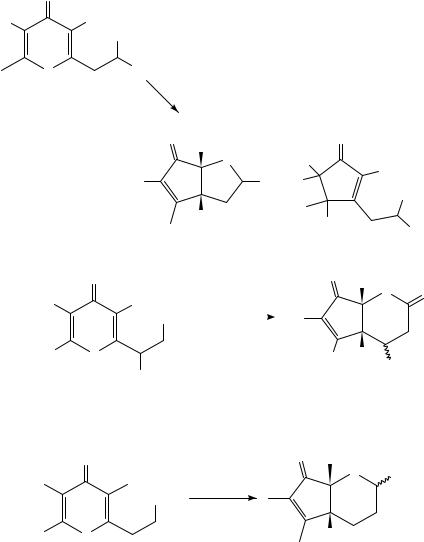
7. Application to the synthesis of complex molecules |
291 |
O |
|
|
R |
R |
|
|
|
OH |
O |
( )n |
R′ |
(135)hν, solvent, rt
(R= H, Me) (R′ = H, Me, Ph)
(n = 1, 2)
O
|
|
R |
|
|
|
|
|
O |
MeO |
|
R |
|
R′ |
+ R |
|
|
|
( )n |
|
|
|
OH |
|
|
solvent = MeOH |
(136) |
|
||
60 − 76% |
|
|||
solvent = CF3 CH2 OH |
43 − 99% |
|
||
|
O |
|
|
|
R2 |
R3 |
|
hν, rt |
|
|
CO2 H |
|
R2 |
|
|
|
CF3 CH2 OH |
||
|
|
|
|
|
R1 |
( )n |
|
25 − 70% |
|
|
|
|
||
O |
|
|
|
|
R4
(R1 = H, Me, Et) (R2 = R4 = H, Me)
(R3 = H, Me, OMe) (n = 0, 1)
O O
hν
CHO
CF3 CH2 OH 64%
O
O |
|
|
R |
|
OH |
OH |
( )n |
|
R′ |
14− 16%
−
O R3
O O
( )n
R1 |
OH |
R4 |
|
|
(137) |
O OCH2 CF3
OH
(138a, b)
SCHEME 31
those cases with a nonhydrogen group at C-3. This may result from a destabilizing interaction in the extended transition state leading to the exo-disposed carbocation. Schultz and coworkers noted comparable diastereoselectivity in the 5-exo cationic cyclizations of 1,5-zwitterions49c.
Intramolecular electrophilic aromatic substitution to give tricyclic products 142 is also a viable process, with trapping efficiency related to the electron density of the arene trap (equation 3)67. With a simple phenyl group pendant, rearrangement to the 2-pyrone was

292 |
John M. Nuss and Frederick G. West |
|
||
O |
|
O |
O |
OH |
|
|
|
||
|
CF3 CH2 O |
|
|
|
|
hν |
|
SiO2 or |
|
|
TFE |
|
H3 O+ |
|
O |
70 % |
|
100 % |
|
|
OH |
|
OH |
|
|
|
|
||
(139a) |
|
(140) |
|
(141a) |
O |
|
O |
|
|
|
|
|
|
|
|
OMe |
H3 O + |
O |
|
|
hν |
|
|
|
|
TFE |
|
|
|
O |
|
|
OH |
|
|
|
|
|
|
(139b) |
|
|
(141b) (61%) |
|
|
|
SCHEME 32 |
|
|
the major pathway, and photocyclization was relatively minor. Additional alkoxy groups on the arene increased the efficiency of the cyclization step, and good yields of tricyclic trapping products were seen.
Y
X
O
O
hν |
|
|
TFE |
|
|
Y |
Y |
(3) |
X |
|
X |
O |
O |
|
|
|
|
+ |
O |
|
OH |
|
|
(142) |
|
|
X = Y = H : 32% |
51% |
|
XY = OCH2 O : 75% |
− |
|
